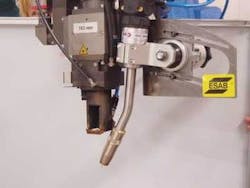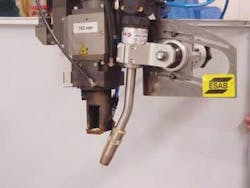WELDING: Laser hybrid process improves welding speed, penetration
Combining laser welding with arc welding to create laser hybrid welding provides major improvements for offshore users, according to Esab.
A typical laser hybrid welding head as developed by Esab.
Laser welding can achieve high speeds of 5-6m a minute, but can only handle small gaps - up to around 0.1mm in the case of plate metal, according to process and application manager Lars-Erik Stridh. Preparatory machining of the joint sections is also required, thus adding to the cost. MIG welding, on the other hand, tolerates large gaps but is very slow, achieving typically 0.4-0.45m a minute.
Putting the two methods together in the laser hybrid process provides a fast welding speed and large gap capability, says Stridh. Other benefits include the penetration properties of laser welding and the addition of consumables and bridge-building properties of MIG.
Laser welding is costly, so it is important to identify applications of the hybrid method with a clear economic advantage. A good example for the offshore sector is provided by the case of riser joint manufacture, involving the longitudinal welding of X65 or X80 steel plate of up to 24mm thickness, including 3mm cladding in 316L or 625 Inconel.
The current method involves four stages of welding: a tack weld with TIG, followed by keyhole plasma welding, MIG welding and finally SAW. To weld a typical 18m length of pipe takes about five hours. In contrast Esab used the laser hybrid method to weld such a joint in 18 minutes, at a rate of one meter a minute.
Stridh sees good opportunities for applying the process in offshore and shipbuilding contexts. It can be used for welding plate in all materials from 4mm to 20mm. This limit will be extended as further development of the process takes place, he says.
The use of consumables in the hybrid method means that the metallurgy of the joint can be influenced. This makes the method suitable for use with high-strength steels, with which consumables are needed to get the required properties out of the joint. Duplex stainless steel, employed widely by the offshore industry, can only be welded with a consumable, making it suitable with the hybrid method, but not with conventional laser welding.
Stridh believes laser hybrid welding has great potential. “It’s an amazing process to work with,” he says. “So far we’ve only scratched the surface of what you can do with it.”
For more information, contact Lars-Erik Stridh, Esab. Tel +46 3150 9353, fax +46 3150 9352,larserik.stridh@esab.se, www.esab.com




